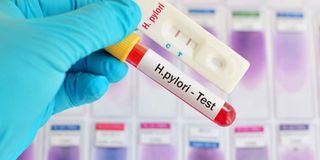The H. pylori menace causing antibiotic resistance

H. pylori is a unique bacterium that has the ability to survive in the stomach, in a hostile environment where most bacteria are almost instantly pulverised by the high acid levels within the stomach.
What you need to know:
- The biggest fright with regard to the presence of H. pylori is that it remains a risk factor for the development of gastric cancer and MALTomas, hence the reason for patients with this risk profile being subjected to testing and treatment.
- It is important to realise that a risk factor is not a cause of cancer. Several other factors come into play, to determine whether a person ultimately gets cancer or not.
Last week, a member of the family fell sick and was taken to the hospital. She was complaining of nausea, vomiting, headache, fever and neck muscle discomfort. The doctor at the emergency department conducted a few tests, including a full blood count and a stool test for the Helicobacter pylori (H. pylori) antigen test, which was found to be positive. She was sent home with a sack of medication to treat the H. pylori infection.
Two days later, her condition had worsened, with dehydration and weakness. A repeat consultation with malaria testing led to a positive malaria test and appropriate treatment for the same. Thankfully she is on the way to recovery.
In the same week, a patient of mine called for a second opinion. I have not seen her for some time. Last week, she visited an outpatient facility feeling nauseous, with general fatigue and body weakness. She was subjected to a battery of tests, including the H.pylori test. Despite requesting for a pregnancy test, it wasn’t conducted. With a positive H. pylori antigen test, she was sent home with her own little package of medications.
She gave up on the medication on the fifth day due to the side effects and proceeded to grab a commercial pregnancy test kit off the counter at her local pharmacy. The test was positive, prompting the call. She was worried about the effect of the medication on her developing baby. Her symptoms were simply a result of her first-trimester pregnancy.
Meanwhile, a friend called for a referral to a paediatric gastroenterologist. She complained that her daughter, who is barely six, is on her third course of H. pylori treatment in a year. She was fed up! She wanted to seek a second opinion because she was not convinced this is what her daughter needed.
All these calls came through in a span of less than three days. When the pharmaceutical industry cried foul over the misuse of H. pylori testing and treatment, many doctors shunned them and assumed they did not want to pay for the cost of care. However, it is becoming clear that, for a number of doctors and clinical officers in the emergency and outpatient departments, especially in the major towns, when there is no other explanation for the patient’s symptoms, then H. pylori infection becomes the fallback diagnosis.
What is disheartening is that most of these patients are not seen continuously by the same doctors or clinicians, hence they fail to note how these treatments are not even helping relieve the symptoms they were trying to alleviate.
The treatment for H. pylori is extremely expensive, ranging from an average of Sh6,000 to Sh14,000 for a course of medication. Throw in the consultation fees and the tests and a single visit will cost anything from Sh15,000 to 25,000.
To put this into context, evidence points to at least one in two persons walking around, harbouring this notorious bacterium in their stomach. It is fascinating to hear patients referring to the bacteria instead of the condition it supposedly causes. I have never heard of a patient reporting to be carrying Plasmodium falciparum infection. They simply state that they have malaria! So, what is different in this case?
H. pylori is a unique bacterium that has the ability to survive in the stomach, in a hostile environment where most bacteria are almost instantly pulverised by the high acid levels within the stomach. It is transmitted through the faeco-oral route, meaning one literally swallowed it in food or drink, contaminated by stool from a person infected by H. pylori. Children tend to get infected from age three to around five for the first time. The infection is more common among children than adults. One can get re-infected throughout life, even after treatment.
To this end then, what are the treatment guidelines? For children, test for H. pylori, only if the child demonstrates obvious symptoms. These include children confirmed to have peptic ulcers, children with a family history of gastric (stomach) cancer, and children with a special type of cancer called Mucosa-associated lymphoid tissue (MALT) lymphoma (MALToma). Minor symptoms of dyspepsia do not warrant testing for H. pylori.
For adults, the same guidelines apply, and in addition, patients <60 years, who have dyspepsia without a proper diagnosis of the cause, patients who require to be put on long-term treatment by a specific group of drugs called NSAIDS, and patients who have unexplained iron-deficiency anaemia.
The biggest fright with regard to the presence of H. pylori is that it remains a risk factor for the development of gastric cancer and MALTomas, hence the reason for patients with this risk profile being subjected to testing and treatment. It is important to realise that a risk factor is not a cause of cancer. Several other factors come into play, to determine whether a person ultimately gets cancer or not. An important caution with regard to the treatment of H. pylori is that this bacterium is responsive to a small range of antibiotics to eradicate it. The treatment is usually a combination of at least two antibiotics and a proton pump inhibitor (PPI - a drug that disables the stomach’s acid-making capacity, reducing acid and allowing the lining of the stomach to heal faster); the infamous triple therapy kit.
More importantly is that within this range of antibiotics, H. pylori has a very high rate of developing resistance. Unfortunately, most of these medications are also rather unpalatable, compromising the patient’s ability to comply with the treatment regimen. Many patients give up after sustained nausea, vomiting, metallic taste and itching.
The repeated incomplete treatments we are seeing across board are resulting in increased antimicrobial resistance; yet the patients being treated do not require the treatment in the first place! We need to put a stop to this menace! Antimicrobial resistance is our currently developing pandemic. We can avert this course if we put our foot down and say no to unnecessary triple therapy kits!
Dr Bosire is an obstetrician/ gynaecologist





